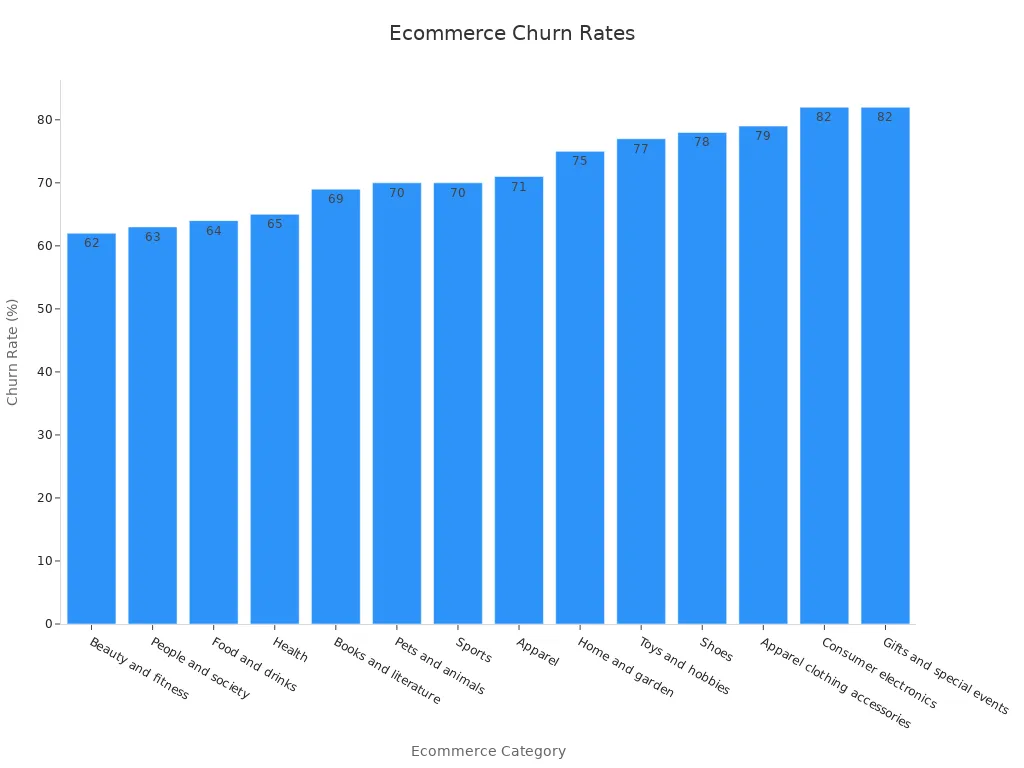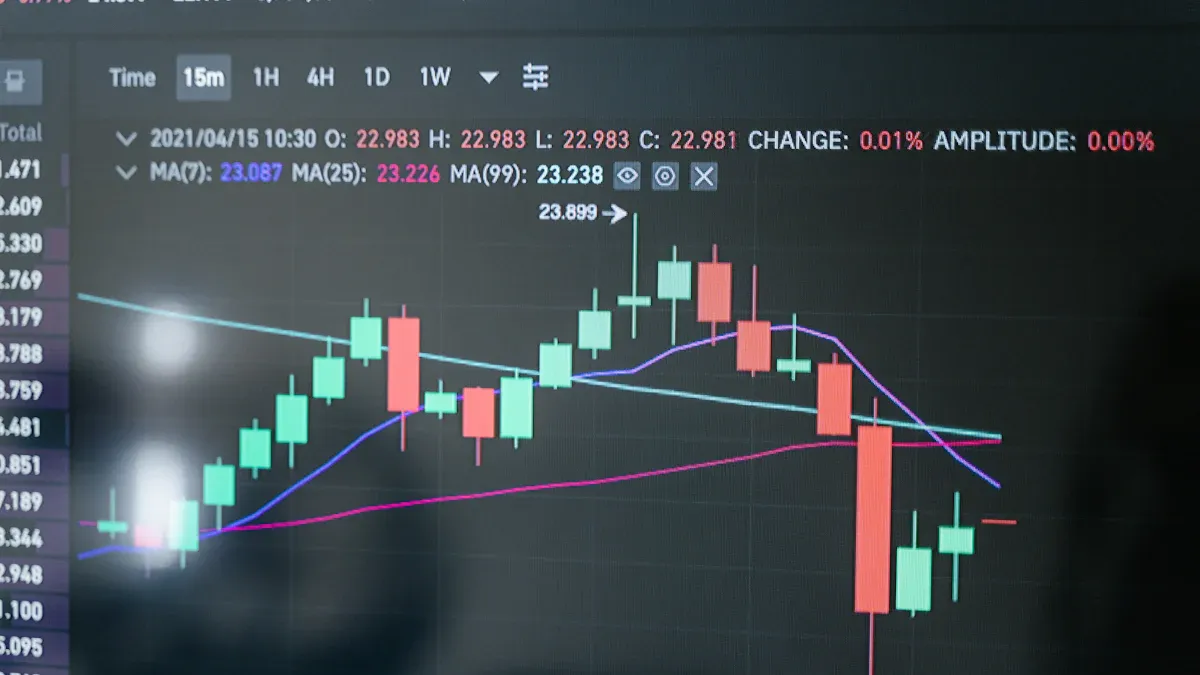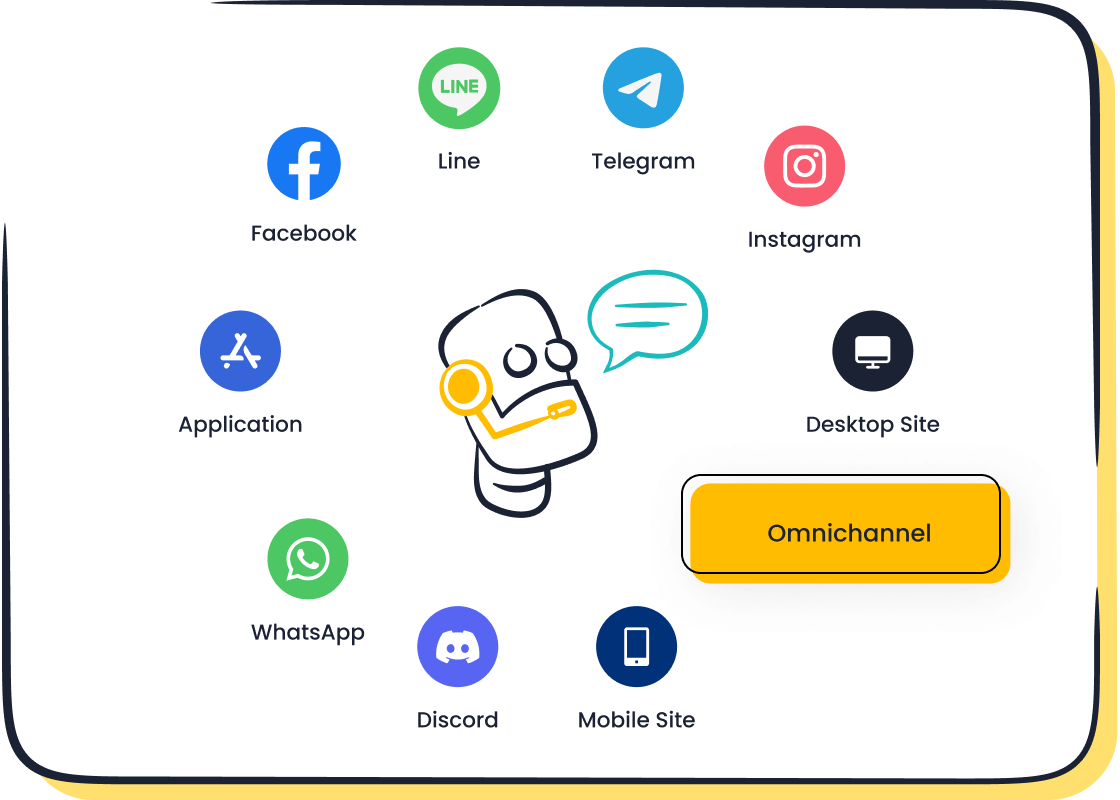Understanding the Average Churn Rate for Ecommerce Stores

Recent studies reveal the average churn rate for ecommerce often exceeds 60% across many categories, with some segments like consumer electronics reaching 82%.

High churn in global ecommerce threatens retention, revenue, and ecommerce growth rate. Repeat customers, though only 21% of the customer base, deliver 44% of revenue. The ecommerce market requires constant innovation to reduce churn and boost retention. Peer-reviewed journals and industry reports, such as those from Statista and IEEE, confirm these trends. Sobot AI empowers global ecommerce brands to address churn through omnichannel engagement and automation, supporting ecommerce trends focused on customer experience.
| Metric | Typical Benchmark | Action Threshold |
|---|---|---|
| Customer Churn Rate | 5-7% per year | Above 10% |
| Repeat Purchase Rate | 20-30% | Below 20% |
| Customer Retention Rate | 90% or higher | Below 85% |
Churn Rate Basics
What Is Churn?
Churn describes the rate at which customers stop buying from an ecommerce business over a set period. In ecommerce, churn signals when shoppers leave a store and do not return to make another purchase. For example, if an online store has 1,000 customers at the start of the month and loses 100 by the end, the churn rate is 10%. Churn can happen for many reasons, such as poor service, high prices, or better offers from competitors. Ecommerce brands track churn to understand how well they keep customers coming back.
Types of Churn
Ecommerce companies face two main types of churn. Voluntary churn happens when customers choose to leave on their own. They may switch to another store or lose interest in a product. Involuntary churn occurs when customers leave because of issues outside their control. Payment failures, expired cards, or technical errors often cause involuntary churn. Both voluntary churn and involuntary churn impact ecommerce stores. For example, a shopper may want to buy again but cannot because their payment did not go through. Sobot helps ecommerce brands reduce involuntary churn by offering 24/7 support and automated reminders for failed payments.
Tip: Identifying the type of churn helps ecommerce businesses create better solutions for customer retention.
Why It Matters
Churn matters in ecommerce because it affects growth and profits. High churn means fewer repeat customers and lower revenue. Studies show that acquiring a new customer can cost five times more than keeping an existing one (Forbes). Ecommerce brands that lower churn see higher customer lifetime value and stronger brand loyalty. Sobot’s omnichannel solutions help ecommerce stores engage customers across channels, reducing churn and boosting satisfaction. Tracking churn gives ecommerce leaders the data they need to improve service and grow their business.
Churn Rate Calculation
Key Metrics
Ecommerce businesses rely on several key metrics to understand churn. The most important metric is the customer churn rate, which shows the percentage of customers who stop buying from an ecommerce store during a set period. Other important metrics include the repeat purchase rate and customer retention rate. These numbers help ecommerce leaders see how well they keep customers coming back. Tracking churn over time allows ecommerce brands to spot trends and react quickly. Sobot’s analytics tools help ecommerce companies monitor these metrics in real time, making it easier to address churn before it affects revenue.
Calculation Formula
Calculating churn in ecommerce starts with a simple formula. Amplitude defines customer churn rate as:
Churn Rate (%) = (Number of customers lost during a period / Number of customers at the start of the period) × 100
For example, if an ecommerce store starts the month with 200 customers and loses 30, the churn rate is 15%. LoyaltyLion explains that subscription ecommerce uses a slightly different formula. It includes new customers acquired during the period to avoid underestimating churn. For non-subscription ecommerce, brands often use cohort analysis. They track how many customers from a group make repeat purchases over time. If 3,000 customers buy in January and only 700 return within six months, the churn rate is 77%. This approach gives ecommerce businesses a clearer view of customer behavior.
Common Pitfalls
Many ecommerce brands face challenges when calculating churn. The table below highlights common pitfalls:
| Business Model / Category | Churn Rate Range | Notes / Pitfalls Highlighted |
|---|---|---|
| Subscription ecommerce | 5% - 10% monthly | Ignoring new customer acquisition can mask true churn rates |
| Non-subscription ecommerce | 20% - 30% annually | Churn must be inferred; direct cancellation data unavailable |
| Average ecommerce overall | ~77% annually | High churn due to single-purchase behavior |
| Product category variation | 77% (toys), 78% (shoes) | Different categories have widely varying churn rates |
| Seasonal and economic factors | N/A | Fluctuations impact churn interpretation; often overlooked |
| Customer segmentation effects | N/A | New customers churn faster; acquisition channel matters |
| Customer service impact | 67% churn due to poor service | Service quality directly affects retention |
Note: Ecommerce brands should use cohort analysis and track average repeat purchase timelines to avoid errors. Sobot’s unified analytics help ecommerce stores avoid these pitfalls by providing accurate, real-time churn data.
Average Churn Rate for Ecommerce

2024-2025 Data
The average churn rate for ecommerce continues to challenge online retailers in 2024 and 2025. Recent industry reports show that the average churn rate for ecommerce stores remains high, often exceeding 60% across many categories. In some segments, such as consumer electronics, churn rates can reach as high as 82%. These numbers highlight the ongoing struggle for customer retention in the global ecommerce market. Repeat customers, although they make up only a small portion of the customer base, contribute a significant share of total revenue. For example, repeat buyers account for 44% of revenue, even though they represent just 21% of all customers. This trend demonstrates the critical impact of churn on the growth and stability of the ecommerce market.
Global ecommerce brands must pay close attention to these figures. High churn rates signal that many customers do not return after their first purchase. This pattern can slow business growth and reduce profitability. Sobot helps ecommerce businesses address these challenges by providing omnichannel engagement tools and AI-powered automation. These solutions enable brands to connect with customers across multiple channels, improving retention and reducing churn.
Industry Benchmarks
Comparing the average churn rate for ecommerce to other industries provides valuable context for online retailers. The following table summarizes benchmark churn rates across several market segments:
| Market Segment | Average Churn Rate (%) | Notes/Context |
|---|---|---|
| Wholesale | 56 | Highest churn rate due to competitive pricing and transactional nature |
| Consumer Packaged Goods (CPG) | 40 | High churn influenced by consumer trends and pricing sensitivity |
| Subscription Services | 6-8 | Typical churn range for subscription-based ecommerce |
| Clothing Subscription Boxes | ~10.54 | Monthly churn rate specific to clothing subscription boxes |
| SaaS | 3.5-5 | Includes B2B SaaS (3.5%-4.67%) and B2C SaaS (higher churn) |
| Streaming Services | 37 | High churn due to competition and customer desire for variety |

The average churn rate for ecommerce stands out as one of the highest among these sectors. Wholesale and consumer packaged goods also experience significant churn, but subscription-based services and SaaS companies report much lower rates. For example, B2B SaaS companies have an average churn rate of 3.5%, while consumer-facing SaaS sees rates between 6.5% and 8%. These differences reflect the unique challenges of the ecommerce market, where customers often make one-time purchases and have many alternatives.
Median churn rates offer a more accurate benchmark than averages, as they reduce the impact of outliers. For SaaS, the median churn rate is about 4.79%. The Media & Entertainment industry has a median churn rate close to 5.23%. These figures include both voluntary churn, where customers choose to leave, and involuntary churn, such as payment failures. Segmenting churn data by customer type and pricing helps ecommerce businesses understand their performance and identify areas for improvement.
Tracking the average churn rate for ecommerce is essential for business health. High churn can indicate problems with customer experience, product quality, or service delivery. Sobot’s unified analytics platform allows ecommerce brands to monitor churn in real time, helping them respond quickly to negative trends and improve customer retention.
Seasonal Patterns
Seasonal patterns play a significant role in the average churn rate for ecommerce. Monthly churn rates can fluctuate due to the varying lengths of months. For example, February has 28 or 29 days, while other months have 31 days. This difference creates about a 10% variation in month duration, making direct month-over-month churn comparisons challenging. Analyzing churn over periods that are multiples of seven days helps account for weekend-related seasonality.
Certain segments of the ecommerce market experience dramatic seasonal effects. A Halloween store, for instance, sees a surge in customers before the holiday, followed by a sharp increase in churn afterward. This pattern suggests that annual churn analysis provides a clearer picture of customer retention than monthly figures. Global ecommerce brands must recognize these seasonal trends to plan effective retention strategies.
Sobot’s AI-driven solutions help ecommerce businesses manage these seasonal fluctuations. Automated marketing campaigns and proactive customer engagement keep shoppers informed and engaged throughout the year. By understanding and addressing seasonal churn, brands can maintain stronger relationships with their customers and drive long-term growth in the global ecommerce market.
Note: Monitoring the average churn rate for ecommerce throughout the year helps businesses spot seasonal risks and opportunities. Sobot’s omnichannel tools support brands in adapting to these changes, ensuring consistent customer engagement.
Ecommerce Trends and Churn
Market Shifts
The ecommerce market continues to evolve rapidly in 2024 and 2025. Global ecommerce brands face new challenges as consumer behavior shifts. Subscription models have grown at a 71% compound annual growth rate, but churn remains a major concern for these businesses. Many companies now focus on building long-term relationships with customers to reduce churn. Data privacy has become a top priority, with 47% of consumers switching brands due to poor data policies. These market shifts force ecommerce brands to rethink their retention strategies and adapt quickly to changing trends.
| Ecommerce Trend | Data Point / Statistic | Relation to Churn Rate / Retention Impact |
|---|---|---|
| AI-driven Personalization | 80% of consumers more likely to return with personalized experience | Directly increases returning buyers, reducing churn |
| Subscription Models | 71% CAGR growth; churn rate identified as a main challenge | Subscription churn is a key issue businesses must address |
| CRM Strategies | Improve retention rates by 5%; increase profits by 25% to 95% | Directly improves customer retention, lowering churn |
| Marketing Automation | Reduces cart abandonment through personalized follow-ups | Indirectly reduces churn by improving conversion and engagement |
| Data Privacy Concerns | 47% of consumers switch companies due to poor data policies | Highlights importance of data privacy in customer retention and churn |
Customer Expectations
Customer expectations in global ecommerce have never been higher. Shoppers want fast, seamless, and personalized experiences every time they interact with a brand. Research shows that 80% of consumers are more likely to return to an ecommerce store that offers a personalized experience. Brands that fail to meet these expectations risk higher churn rates. Many customers expect real-time support and consistent communication across all channels. Sobot helps ecommerce brands deliver on these expectations by providing omnichannel support and AI-powered chatbots. These tools allow businesses to engage customers on their preferred platforms, improving satisfaction and reducing churn.
Note: Meeting customer expectations is essential for reducing churn and driving growth in the ecommerce market.
AI and Automation
AI and automation now play a critical role in the global ecommerce landscape. Marketing automation reduces cart abandonment by sending personalized follow-ups, which helps lower churn. CRM strategies improve retention rates and can boost profits by up to 95%. Sobot’s AI-driven solutions enable ecommerce brands to automate customer engagement, streamline support, and unify data across channels. The Sobot chatbot operates 24/7, providing instant responses and proactive outreach. These features help ecommerce businesses retain more customers and adapt to new churn trends. As ecommerce trends continue to shift, brands that leverage AI and automation will stay ahead in the competitive global ecommerce market.
Churn Factors
Service Quality
Service quality stands as a leading factor in ecommerce churn. Customers expect fast, helpful, and friendly support. When ecommerce brands fail to deliver, shoppers leave and do not return. According to a Microsoft report, 58% of global ecommerce customers stop buying after a single poor service experience (source). Voluntary churn often results from slow responses or unresolved issues. Involuntary churn can also occur if customers cannot reach support during payment or order problems. Sobot helps ecommerce businesses improve service quality by offering 24/7 AI-powered chatbots and unified support across channels. These tools ensure customers always receive quick and accurate help, reducing both voluntary churn and involuntary churn.
Tip: Consistent service quality builds trust and keeps ecommerce customers coming back.
Product Experience
Product experience shapes how customers view an ecommerce brand. Shoppers want products that match descriptions, arrive on time, and meet expectations. Negative reviews, damaged goods, or confusing return policies drive customers away. In global ecommerce, 72% of buyers say product quality and delivery speed influence their loyalty (source). Poor product experience leads to voluntary churn, as customers choose other stores. Sobot’s omnichannel solution lets ecommerce brands gather feedback and resolve complaints quickly. By tracking product issues and acting fast, businesses can improve satisfaction and reduce churn.
- Key factors affecting product experience in ecommerce:
- Accurate product descriptions
- Reliable shipping and delivery
- Easy returns and refunds
Payment Issues
Payment issues cause significant churn in ecommerce. Failed transactions, declined cards, or complicated checkout processes frustrate customers. Involuntary churn often happens when payment systems reject valid purchases. Voluntary churn can occur if shoppers find the process too slow or confusing. Research shows that 17% of global ecommerce shoppers abandon carts due to payment problems (source). Sobot’s AI chatbot can send automated reminders for failed payments and guide users through checkout. This support reduces involuntary churn and helps ecommerce brands recover lost sales.
Note: Streamlined payment experiences keep ecommerce customers satisfied and loyal.
Retention Strategies

Personalization
Personalization stands at the core of successful ecommerce retention strategies. Leading ecommerce brands use data to understand customer preferences and behaviors. They recommend products based on past purchases, send targeted emails, and offer special discounts to loyal shoppers. These actions show customers that the brand values their unique needs.
Research shows that ecommerce businesses with strong personalization achieve customer retention rates of 35% or higher. Most brands see rates between 25% and 30%, but top performers reach even greater heights by focusing on tailored experiences. Personalization increases customer satisfaction, boosts conversion rates, and encourages repeat purchases. When customers feel understood, they return more often and spend more per order. This approach raises customer lifetime value and directly reduces churn.
Personalized retention strategies also save money. Retaining an existing ecommerce customer costs much less than acquiring a new one. Even small improvements in retention can lead to big gains in profitability. Key metrics such as repeat customer rate, average order value, and customer engagement all improve with effective personalization. Ecommerce brands that invest in these strategies build stronger relationships and see measurable results in retention and revenue.
Tip: Use customer data to create personalized offers and messages. This simple step can transform one-time buyers into loyal fans.
Sobot Chatbot Solutions

AI-powered chatbots have become essential tools for ecommerce retention. Sobot’s chatbot solution helps ecommerce brands engage customers across multiple channels, providing instant support and proactive communication. The chatbot answers common questions, guides shoppers through checkout, and sends reminders about abandoned carts or failed payments.
Industry reports highlight the impact of AI chatbots on ecommerce retention. Companies using solutions like Sobot see a 25% reduction in customer effort and a 10% increase in satisfaction. Proactive service strategies, including chatbots, can lower churn rates by 25%. AI-powered communication also creates more upsell opportunities, with some brands seeing a 15% increase. Sobot’s chatbot reduces support requests by 30%, allowing human agents to focus on complex issues and improving overall resource allocation.
Sobot’s chatbot stands out for its omnichannel support and 24/7 availability. It operates in multiple languages and integrates with platforms like WhatsApp and SMS. Ecommerce brands use Sobot to automate routine tasks, deliver personalized messages, and keep customers engaged throughout their journey. These features help reduce churn and drive higher retention rates.
- Key benefits of Sobot’s chatbot for ecommerce retention:
- Instant, accurate responses to customer inquiries
- Proactive outreach for payment and order issues
- Seamless support across all major channels
- Data-driven insights for continuous improvement
Note: Sobot’s chatbot empowers ecommerce brands to deliver consistent, high-quality service that keeps customers coming back.
Success Story: OPPO
OPPO, a global leader in smart devices, faced challenges with high inquiry volumes during peak ecommerce periods. The company partnered with Sobot to enhance its customer service and retention efforts. By implementing Sobot’s AI chatbot and ticketing system, OPPO automated responses to frequent questions and freed up human agents for complex cases.
The results were impressive. OPPO achieved an 83% chatbot resolution rate and a 94% positive feedback score from customers. Most importantly, the company saw a 57% increase in repurchase rate, a key indicator of improved retention. Sobot’s solution also helped OPPO reduce knowledge base maintenance by 90%, streamlining operations and improving efficiency.
OPPO’s experience demonstrates how advanced chatbot solutions can transform ecommerce retention. By integrating Sobot’s tools, OPPO unified its customer channels, improved data access, and delivered faster, more accurate support. The company’s success highlights the value of AI-driven engagement in reducing churn and building long-term loyalty.
OPPO’s partnership with Sobot shows that investing in the right technology can deliver measurable gains in ecommerce retention and customer satisfaction.
Ecommerce brands face high churn rates, which can limit growth and profits. Tracking churn helps ecommerce leaders spot problems early and adapt to new trends. AI-driven solutions, such as Sobot, give ecommerce businesses tools to improve retention and customer satisfaction.
- AI chatbots provide instant support and reduce churn in ecommerce.
- Predictive analytics help ecommerce brands find at-risk customers and offer timely help.
- Personalized engagement increases repeat purchases and loyalty in ecommerce.
Ecommerce companies that use these strategies see higher customer lifetime value and stronger long-term results. Sobot’s omnichannel platform supports ecommerce growth by making customer journeys smoother and more personal.
FAQ
What is the average churn rate for ecommerce stores in 2024?
Recent data shows the average churn rate for ecommerce stores exceeds 60% in 2024. Some categories, such as consumer electronics, reach up to 82%. Tracking churn helps ecommerce brands like Sobot’s clients improve retention and boost revenue.
Why does churn matter so much for ecommerce businesses?
Churn directly impacts revenue and growth. Studies show repeat customers, who make up only 21% of buyers, generate 44% of revenue. Lowering the average churn rate for ecommerce increases retention and customer lifetime value.
How can ecommerce brands reduce churn effectively?
Ecommerce brands use AI chatbots, omnichannel support, and personalized engagement to reduce churn. Sobot’s solutions automate customer service, send proactive reminders, and unify data. These tools help ecommerce stores improve retention and customer satisfaction.
What role does Sobot play in improving ecommerce retention?
Sobot provides AI-powered chatbots and omnichannel platforms. These tools help ecommerce brands lower the average churn rate for ecommerce by offering 24/7 support, instant responses, and personalized communication. OPPO, a Sobot client, increased its repurchase rate by 57% after using Sobot.
How do seasonal trends affect the average churn rate for ecommerce?
Seasonal events, like holidays, cause spikes in churn. For example, Halloween stores see high churn after October. Ecommerce brands must monitor churn year-round. Sobot’s analytics help businesses spot seasonal risks and adjust retention strategies quickly.
See Also
Increasing Online Sales With Effective Ecommerce Live Chat
Enhancing Customer Satisfaction In Ecommerce Using Chatbots
Expert Strategies For Live Chat Success In Retail
